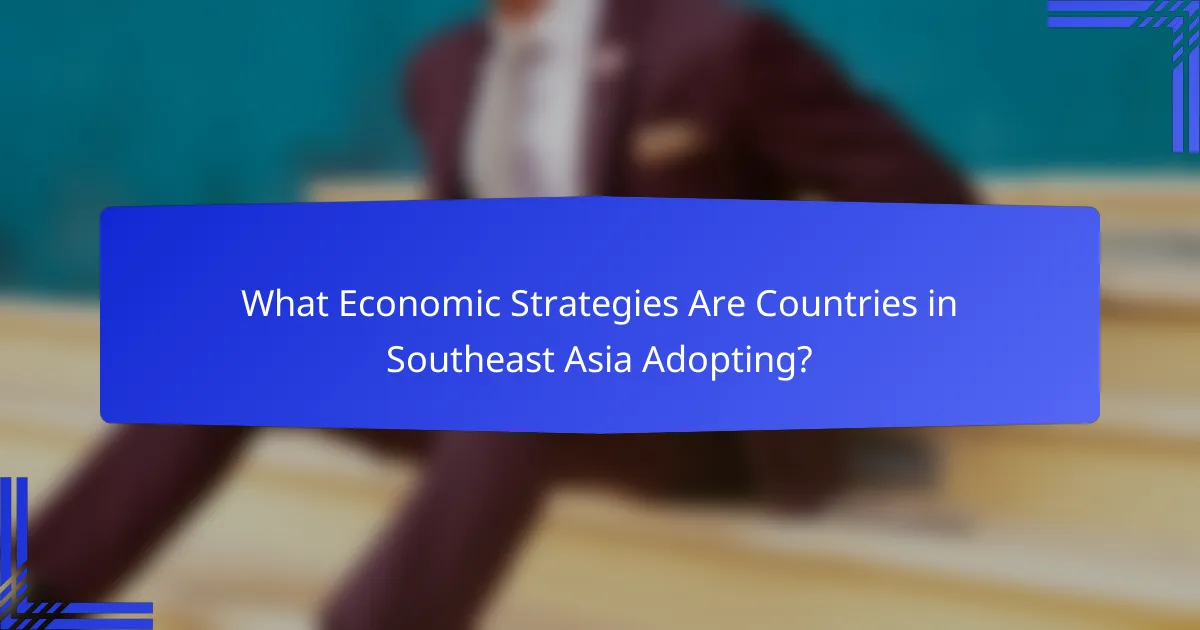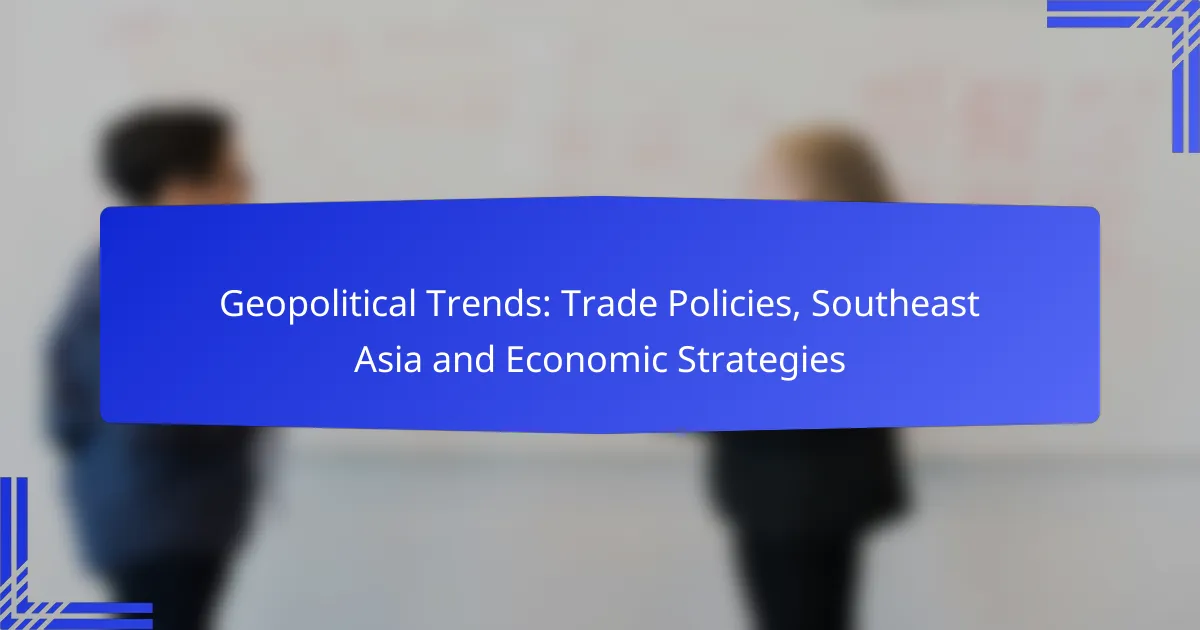Trade policies play a crucial role in shaping the economic landscape of Southeast Asia, influencing import and export dynamics, investment flows, and regional cooperation. As countries in the region adopt innovative economic strategies focused on digital infrastructure and sustainable development, they aim to enhance resilience and competitiveness in an evolving global market. However, these policies also present challenges that necessitate careful management to ensure geopolitical trends and improved living standards.

How Are Trade Policies Shaping Southeast Asia’s Economy?
Trade policies significantly influence Southeast Asia’s economy by affecting import and export dynamics, investment flows, and regional cooperation. These policies can enhance economic growth, create jobs, and improve living standards, but they also pose challenges that require careful management.
Impact of tariffs on regional trade
Tariffs directly affect the cost of goods traded between countries, influencing pricing and competitiveness. In Southeast Asia, countries often impose tariffs to protect local industries, which can lead to higher prices for consumers and reduced trade volumes. For instance, a country raising tariffs on imported electronics may see a decline in imports while local manufacturers struggle to meet demand.
Additionally, retaliatory tariffs can escalate trade disputes, further complicating regional trade relationships. Businesses must stay informed about tariff changes to adapt their pricing strategies and supply chains accordingly.
Influence of trade agreements like RCEP
The Regional Comprehensive Economic Partnership (RCEP) is a significant trade agreement that aims to reduce tariffs and enhance trade cooperation among its member countries. By streamlining trade regulations and lowering barriers, RCEP promotes economic integration, which can lead to increased trade flows and investment opportunities across Southeast Asia.
Businesses can benefit from RCEP by accessing larger markets and diversifying their supply chains. However, they must also navigate the complexities of compliance with varying regulations across member states.
Effects of US-China trade tensions
The ongoing trade tensions between the US and China have profound implications for Southeast Asia’s economy. As companies seek to avoid tariffs imposed on Chinese goods, many are relocating their supply chains to Southeast Asian countries, creating new investment opportunities. This shift can boost local economies but may also lead to increased competition for resources and labor.
Furthermore, countries in the region must carefully balance their trade relationships with both the US and China to avoid being caught in the middle of geopolitical disputes.
Role of ASEAN in trade policy
The Association of Southeast Asian Nations (ASEAN) plays a crucial role in shaping trade policies within the region. By promoting economic integration and facilitating dialogue among member states, ASEAN helps to create a more cohesive trade environment. Initiatives such as the ASEAN Free Trade Area (AFTA) aim to reduce tariffs and enhance trade among member countries.
ASEAN’s collaborative approach allows for collective bargaining power on the global stage, enabling member countries to negotiate better trade terms with larger economies.
Emerging markets and trade dynamics
Southeast Asia is home to several emerging markets that are rapidly evolving in terms of trade dynamics. Countries like Vietnam, Indonesia, and the Philippines are experiencing significant economic growth, attracting foreign investment and increasing their export capabilities. These emerging markets often benefit from lower labor costs and a young workforce, making them attractive for manufacturing and services.
However, businesses must be aware of the varying levels of infrastructure development, regulatory environments, and market access challenges in these emerging markets. Understanding local conditions is essential for successfully navigating trade opportunities in the region.

What Economic Strategies Are Countries in Southeast Asia Adopting?
Southeast Asian countries are increasingly adopting economic strategies focused on digital infrastructure, sustainable development, export diversification, and government incentives for startups. These approaches aim to enhance economic resilience and competitiveness in a rapidly changing global landscape.
Investment in digital infrastructure
Investment in digital infrastructure is a key strategy for Southeast Asian nations to boost their economies. Countries are prioritizing the development of high-speed internet, mobile connectivity, and smart technologies to facilitate e-commerce and digital services.
For example, nations like Singapore and Vietnam have made significant strides in expanding their digital networks, which has led to increased online business activities. Governments are often collaborating with private sectors to fund these initiatives, ensuring that digital access reaches rural and underserved areas.
Focus on sustainable development
Sustainable development is becoming a central theme in the economic strategies of Southeast Asian countries. This includes promoting green technologies, renewable energy sources, and environmentally friendly practices across various industries.
Countries like Indonesia and Malaysia are implementing policies that encourage sustainable agriculture and forestry management. By aligning economic growth with environmental stewardship, these nations aim to attract foreign investment while addressing climate change challenges.
Export diversification strategies
Export diversification strategies are essential for Southeast Asian economies to reduce dependency on a limited range of products. Countries are actively seeking to expand their export markets by developing new sectors such as technology, pharmaceuticals, and sustainable goods.
For instance, Thailand is working to enhance its automotive and electronics exports, while the Philippines is focusing on business process outsourcing and agricultural products. This diversification helps mitigate risks associated with global market fluctuations and trade tensions.
Government incentives for startups
Government incentives for startups play a crucial role in fostering innovation and entrepreneurship in Southeast Asia. Many countries are offering tax breaks, grants, and funding programs to support new businesses, particularly in tech and creative industries.
Singapore’s Startup SG initiative is a prime example, providing various resources and funding opportunities for entrepreneurs. These incentives not only stimulate local economies but also attract foreign investors looking for promising startups in the region.

How Do Trade Policies Affect E-commerce in Southeast Asia?
Trade policies significantly influence e-commerce in Southeast Asia by shaping market access, regulatory frameworks, and consumer behavior. These policies can either facilitate or hinder online business operations, impacting everything from tariffs to digital trade agreements.
Regulatory impacts on online marketplaces
Regulatory frameworks in Southeast Asia vary widely, affecting how online marketplaces operate. Countries like Singapore have established clear e-commerce regulations, while others may have less defined rules, leading to compliance challenges for businesses. Understanding local regulations, such as data protection laws and consumer rights, is crucial for successful online operations.
For instance, the ASEAN Agreement on E-Commerce aims to harmonize regulations across member states, promoting smoother cross-border transactions. However, companies must still navigate individual country regulations, which can include licensing requirements and tax obligations.
Cross-border e-commerce growth
Cross-border e-commerce in Southeast Asia is experiencing rapid growth, driven by trade agreements and improved logistics. The region’s diverse markets offer significant opportunities for businesses to expand their reach beyond domestic borders. For example, platforms like Lazada and Shopee facilitate cross-border sales, allowing sellers to access millions of consumers across multiple countries.
However, businesses must consider varying import duties, customs regulations, and shipping costs when engaging in cross-border e-commerce. Understanding these factors can help companies optimize their pricing strategies and enhance competitiveness in the region.
Consumer behavior shifts due to trade policies
Trade policies can lead to notable shifts in consumer behavior in Southeast Asia. For example, reduced tariffs on imported goods can make foreign products more affordable, prompting consumers to explore international brands. This shift can increase demand for e-commerce platforms that offer a wider selection of products.
Additionally, as trade policies evolve, consumers may become more aware of their rights and protections, influencing their purchasing decisions. Businesses should adapt their marketing strategies to emphasize compliance with local regulations and consumer rights to build trust and loyalty among shoppers.

What Are the Key Trade Agreements Influencing Southeast Asia?
The key trade agreements influencing Southeast Asia include the Regional Comprehensive Economic Partnership (RCEP), the Comprehensive and Progressive Agreement for [censured]-Pacific Partnership (CPTPP), and the ASEAN Free Trade Area (AFTA). These agreements play a crucial role in shaping trade dynamics, economic cooperation, and market access across the region.
Regional Comprehensive Economic Partnership (RCEP)
The RCEP is a significant trade agreement involving 15 Asia-Pacific countries, including ASEAN members and major economies like China and Japan. It aims to reduce tariffs, enhance trade facilitation, and promote investment among member nations, covering nearly a third of the global economy.
One of the key features of RCEP is its focus on simplifying rules of origin, which allows businesses to benefit from lower tariffs more easily. Companies looking to expand in Southeast Asia should consider how RCEP can provide access to larger markets and lower costs.
Comprehensive and Progressive Agreement for [censured]-Pacific Partnership (CPTPP)
The CPTPP is a trade agreement among 11 Pacific Rim countries that promotes free trade and economic integration. It includes provisions for reducing tariffs, protecting intellectual property, and enhancing labor and environmental standards.
For businesses in Southeast Asia, CPTPP offers a competitive edge by providing preferential access to markets like Canada and Australia. Companies should evaluate their supply chains to leverage the benefits of this agreement, especially in sectors such as agriculture and technology.
ASEAN Free Trade Area (AFTA)
AFTA aims to promote intra-regional trade among ASEAN member states by reducing tariffs and non-tariff barriers. Established in the 1990s, it has significantly boosted trade within Southeast Asia, making it easier for businesses to operate across borders.
Firms should be aware of the Common Effective Preferential Tariff (CEPT) scheme under AFTA, which allows for lower tariffs on goods traded between member countries. Understanding these tariff reductions can help businesses optimize their pricing strategies and enhance competitiveness in the regional market.

What Challenges Do Businesses Face in Southeast Asia’s Trade Environment?
Businesses in Southeast Asia encounter a variety of challenges in the trade environment, primarily due to regulatory complexities, varying compliance standards, and logistical issues. Understanding these challenges is crucial for navigating the region’s diverse markets effectively.
Regulatory compliance hurdles
Regulatory compliance hurdles are significant obstacles for businesses operating in Southeast Asia. Each country has its own set of laws and regulations that can differ widely, making it essential for companies to stay informed about local requirements.
For instance, businesses may face challenges related to import/export permits, tariffs, and local labor laws. Companies should consider engaging local legal experts to ensure compliance and avoid potential fines or delays.
To navigate these hurdles effectively, businesses should create a checklist of necessary permits and regulations for each market they enter. Regularly reviewing these requirements can help prevent compliance issues and streamline operations.
